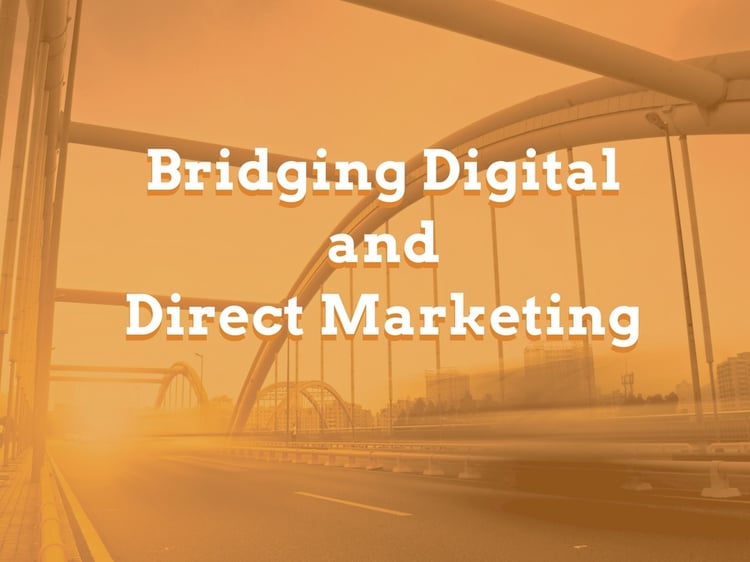Last year, we discussed the state of direct mail and its effectiveness in a digital-first world. And while we found that it was indeed still a powerful force in 2016, a...

Throughout the ascendance of digital marketing, pundits and even marketers themselves have considered the strategy and execution for digital to be completely separate from the traditional methods of advertising, such as those used in direct mail marketing. The truth is that these two types of marketing are more connected than you might think, and it’s time to transform how we view the strategy and tactics used in planning our overall marketing campaigns. Digital marketing and direct marketing can’t be planned effectively if that connection between them is not leveraged. And that connection is the consumer, and the way to bridge the gap between digital and direct marketing is through individualization.
This bridge between the two is something new and exciting, although it’s been discussed and thought about by both traditional and modern marketers for quite some time.
What’s Standing between Your Digital and Direct Mail Marketing?
The idea that digital marketing and direct marketing are two silos with no interaction is partially an extension of the “digital vs direct” battle we’ve seen in every aspect of life. In a sense, it’s no different than brick-and-mortar stores competing with online shopping or eBooks potentially replacing physical publications. These are separate mediums, but the best companies have found a way to maintain a stronghold in both areas.
However, the idea of direct mail marketing working in conjunction with digital marketing is beginning to gain a foothold. For much of the history of digital marketing, online advertising has been kept separate from traditional forms of marketing, such as print campaigns and direct mail pieces. Instead of working together, the online marketing department essentially competes against its own company’s offline advertising efforts. This has had a trickle-down impact on the consumer. Not only is the average customer bombarded with ads across multiple platforms, but since online marketing and traditional marketing run parallel to each other, the campaigns you’re running for your digital program could be in direct conflict with the campaigns for your direct marketing, which sends mixed signals to your consumers about what you want them to do.
Learn why E-commerce marketers must rethink the consumer experience and their role in delivering effective marketing at every touchpoint.
This creates a major problem for businesses and consumers alike. The duplicate costs of separate campaigns to reach the same target audience that come with running direct and digital marketing in silos can cut significantly into a company’s ad budget, impairing that company’s ability to provide the type of marketing that truly motivates consumers. In the end, everybody loses.
This approach also hurts the ability of the direct mail team to generate the response rates that have typically made direct mail marketing an effective option for businesses. Direct mail has always relied on consumer data, but the types of data that are collected to create a picture of the consumer is changing. Direct marketing must also use the same “in the moment” insights the digital marketing department has relied on to create personalized and individualized marketing messages.
Bridging the Divide with an Individualized Marketing Strategy
Many businesses are beginning to come around to the idea that today’s consumer interacts with dozens, if not hundreds, of marketing messages each day, and those messages come from a variety of sources. With so many pitches coming the way of the average customer, it’s impossible and impractical to tell which media lead directly to a purchase. As a result, more marketing departments are shifting away from viewing channels as the main way of differentiating marketing campaigns and moving to planning marketing campaigns around specific target audience segments.
The goal of this approach is to do something that was previously considered impossible — to work towards creating an individualized marketing strategy that could adapt to the wants and needs of each individual customer. It’s something that simply can’t be done without accounting for every interaction between customer and brand, and it’s definitely not doable if internal marketing departments are at odds with each other.
The bridge that’s built between direct marketing and digital marketing facilitates the creation of yet another roadmap — the customer’s path to purchase. The path to purchase tracks every step of the journey between brand awareness and eventual purchase, and every way in which the consumer interacts with the brand throughout that journey. For instance, someone might learn about your company through a shared Facebook link. That could lead them to check out your website for more information, which prompts them to go to a store to see your product in action. After that, they might sign up for your email list to learn more, after which they could finally buy your product from Amazon.
There’s a lot to track here, and it’s easy for a company to think it’s not worth their time and energy. But it’s only through understanding every aspect of the path to purchase that it becomes possible to market to customers individually. Without this guiding document, you’re basically guessing. And if you’re guessing, consumers will know it and find a competitor who’s more interested in in understanding them as a person and as a consumer.
Individualized Marketing Strategy in Action
Even the best-laid marketing plans are useless if they’re not accompanied by action. Sure, it sounds great to be able to market individually to consumers, but it can be hard to visualize how such a strategy might be executed in real life.
Consider the case of a young couple that has purchased their first new home and are interested in putting a garden in their new backyard. Now, imagine your company sells gardening materials. Moving into a new home is a very common trigger for direct marketing, so it’s a good time to send this couple a postcard or letter welcoming them to the neighborhood and offering a discount at your retail store. After all, you have reason to suspect that they might be interested in purchasing items for their new home, but you don’t know exactly what they want just yet. The “Welcome to the Neighborhood” approach is a good way to get your foot in the door and, more importantly, to begin the process of individualization.
However, this couple isn’t going to come into your store and buy a bunch of random gardening-related items. Before they even think about buying, they’re going to do some initial research online — and they might not necessarily do it together. The wife might be more concerned with what items are the best to plant, while the husband could be tasked with researching the tools needed to install and maintain the garden. This fragmented research is likely to be done from several devices. She could be researching on her mobile and he’s using a desktop or laptop, or even flipping through a catalog while checking online reviews and prices.
Including a QR code on your initial direct mail piece is one way to try to tie these devices together, but there’s no guarantee either person will actually use it. The good news is that your path to purchase roadmap will help you to identify the decision points and information sources that consumers typically use as they approach creating a garden for their new home. If either member of the couple has signed up for your email list or an account on your website, you can gain even deeper insights into what you can expect this couple to eventually purchase.
Obtaining all of this information enables you to market more incisively than ever before, without coming across as creepy. You’ll have a better idea of what they actually want, and you’ll be able to deliver the right communication at the right time. Because you went the extra mile to understand your consumers on an individual level, this couple — and others like them — will repay your attention to detail with long-term loyalty and recommendations to others.
The Digital and Direct Marketing Transformation Is Now
Based on the silo-based school of thought that’s dominated marketing culture for far too long, the symbiotic relationship between direct mail marketing and digital marketing may seem unnatural at first. However, the synergy of these two mediums as it relates to implementing a truly individualized marketing strategy proves that this bridge between direct marketing and digital marketing is what marketers have been after all along. The melting pot of data, technology and effectiveness yielded by this bridge between online and offline marketing has resulted in an approach that targets the individual with the information they need, when they need it. It’s the ultimate example of how brands can enrich the lives of their customers, which should be the ultimate goal of any marketing initiative.

